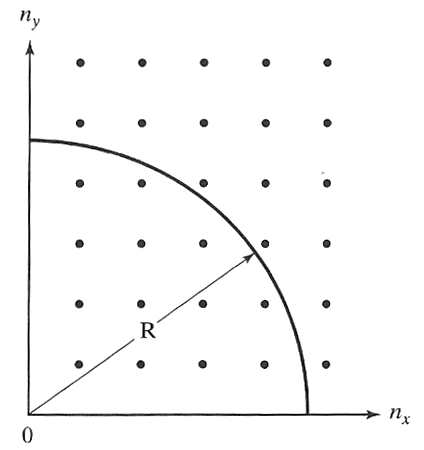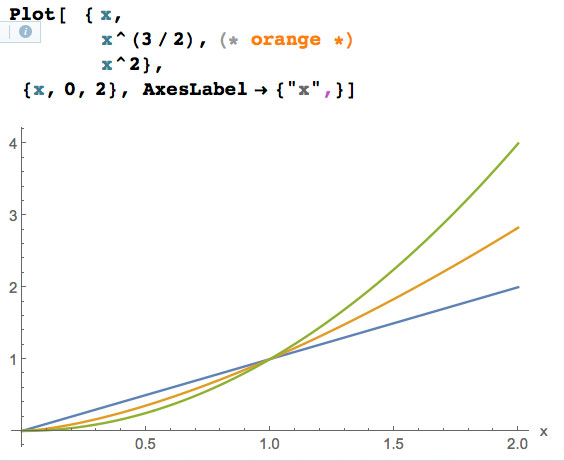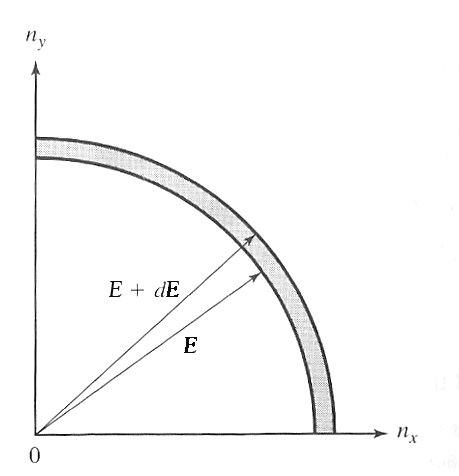Particle in a box
Turning away from spin systems, let's look at a fairly realistic quantum model for an ideal gas of non-interacting particles. We will:
- Solve Schrödinger's equation for a single "particle in a box".
- Find the allowed single-particle energy levels. (These depend on the volume of the box.)
- This will give us the energy levels of a collection of many particles: If the particles interact very little with each other, then the energy of a collection of particles is just the sum of their single-particle energies. We'll assume that we don't need to add any particle-particle interaction terms.
- Figure out how to count the number of ways of arranging particles for a given total energy! (entropy)
With this information in hand, we can make calculations of the equilibrium properties of a fairly realistic gas of particles which obey quantum mechanics instead of classical mechanics.
Schrödinger equation
In classical mechanics, the energy of a particle moving in one dimension is given by the "Hamiltonian" of the system: $${\mathcal H} \equiv \frac{p^2}{2m} +V(x) = E.$$ where the first term is the kinetic energy (written in terms of momentum, $p=mv$) and the second term is the potential energy of the particle.
In quantum mechanics, there is a wave function $\psi(x)$ called the probability amplitude.
The probability to find a single particle with a position between $x$ and $x+dx$ is $|\psi(x)^2|$.
The time-independent probability amplitude - the probability when the potential energy is not changing with time - satisfies the time-independent Schrödinger equation which strikingly resembles the Hamiltonian, with the momentum defined in terms of an "operator" $p\rightarrow i\hbar\partial/\partial x$: $$-\frac{\hbar^2}{2m}\frac{\partial^2}{\partial x^2}\psi(x) + V(x)\psi(x) = E\psi(x).$$
 The particle in a box or infinite well problem consists of assuming that the potential is...
$$V(x) =\left\{ \begin{matrix} \infty & \text{if }x \lt 0\\ 0 & \text{if }0 \lt x \lt L \\ \infty & \text{if }L \lt x \end{matrix} \right.$$
The particle in a box or infinite well problem consists of assuming that the potential is...
$$V(x) =\left\{ \begin{matrix} \infty & \text{if }x \lt 0\\ 0 & \text{if }0 \lt x \lt L \\ \infty & \text{if }L \lt x \end{matrix} \right.$$
So, inside the box, the equation is now: $$-\frac{\hbar^2}{2m}\frac{\partial^2}{\partial x^2}\psi(x) = E\psi(x).$$ $E$, the energy, is a constant in this differential equation. It looks like just the kinetic energy term of the Hamiltonian. [And no rotational kinetic energy, just linear kinetic energy: This is like a low temperature ideal gas which cannot be excited into higher angular momentum states.]
- the wave function must vanish outside of the box.
- The wave function is continuous across the boundary.
Therefore, the solutions inside the box must vanish at $x=0$ and $x=L$.
The solutions are $\sin$ and $\cos$ functions, but the $\cos$ function does not vanish at $x=0$, so
for $0 < x < L$ are $$\psi(x) = A\sin kx,$$
where $$k=n\frac{\pi}{L},\ \ \text{for integer values, }\ n=1,2,3...$$
The "normalized" ($\int_0^L |\psi(x)|^2\,dx=1$) solutions are:
$$\psi_n(x)=\sqrt{\frac 2L}\sin\left( \frac{n\pi}{L}x\right).$$
which look like this:

Test the solution
- Show that $\psi_n(x)=A\sin\left(n\frac{\pi}{L}x\right)$ (where $n$ is a positive, non-zero integer) always vanishes at both $x=0$ and $x=L$.
- Show that $\psi_n(x)$ is a solution to the Schrödinger equation below, by substituting it in, and finding the value of the constant $E_n$: $$-\frac{\hbar^2}{2m}\frac{\partial^2}{\partial x^2}\psi_n(x) = E_n\psi_n(x).$$
Carrying through the second derivative, we find that the allowed energies are (for any positive integer $n$): $$E_n = \frac{\pi^2\hbar^2}{2mL^2}n^2.$$
3-d box
Now, if the box is a 3-dimensional, cubic container, instead of a 1-d container, with extension $L$ in each direction, then the solutions to the 3-d Schrödinger equation is the product of 1-d solutions: $$\Psi_j(x,y,z)=\psi_{n_x}(x)\psi_{n_y}(y)\psi_{n_z}(z),$$ where the energy depends on the integers $n_x$, $n_y$, and $n_z$ according to: $$\begin{align}E_j &= \frac{\pi^2\hbar^2}{2m}\left(\frac{n_x^2}{L^2}+\frac{n_y^2}{L^2} + \frac{n_z^2}{L^2}\right) = \frac{\pi^2\hbar^2}{2mL^2}n_j^2\\ & = \frac{\pi^2\hbar^2}{2mV^{2/3}}n_j^2.\end{align}$$
The energy is proportional to $n_j^2=n_x^2+n_y^2+n_z^2$. The lowest energy level (ground state) is: $$E_1 = \frac{\pi^2\hbar^2}{2mV^{2/3}}\left(1^2+1^2+1^2\right) = \frac{\pi^2\hbar^2}{2mV^{2/3}}3.$$ There is clearly only one combination of $n_x$, $n_y$, and $n_z$ to get this energy.
The next energy level, $j=2$, occurs when one of the integers is 2 instead of 1, for example, $\{n_x,n_y,n_z\}=\{1,1,2\}\Rightarrow n_2^2 = 1^2+1^2+2^2 = 6$.
There are three combinations such that the sum of squares equals 6. The other two are: $\{1,2,1\}$ and $\{2,1,1\}$ So, the degeneracy of this energy level is $g_2 = 3$.
Because only $\{1,1,1\}$ gives the lowest energy, with n_1^2=3, we had $g_1=1$.
Next levels
What are $n_j^2$ and $g_j$ for the next two energy levels $j=3$ and $j=4$?
Give an example of one combination of integers, $\{n_x,n_y,n_z\}$ for $j=3$
Macrostate
Each combination of $n_x$, $n_y$, $n_z$ is a different quantum state (microstate). But there are $g_j$ different quantum states that share the same energy.
A description of the macrostate of the system would consist of specifying how many particles $N_j$ are in each energy level $j$ of the system, irregardless of how they're arranged in the quantum states.
As $V$ increases, the energy levels get closer together, quasi-continuously.
Carter estimates for helium, at room temperature, with a one-liter box, a typical $n_j\approx 2\times10^9$
Density of states
For thermodynamic purposes, we need to figure out how to count the number of microstates for each macrostate. One microstate would be an enumeration of how many particles there are in each quantum state. So we start by trying to count the number of quantum states.
If the quantum levels are very close together, we can approximate the discrete function $n_j$ as a continuous function $n(E)$ of a continuously varying $E$.
The density of states $g(E)$ is defined so that the number of quantum states with energies between $E$ and $E+dE$ is $g(E)dE$.
If there is 1 state for every integer $n_x$, $n_y$, $n_z$, then we can imagine these as points spread uniformly
in one octant of 3-d space with a density of 1 point per unit volume.
integer $n_x$, $n_y$, $n_z$, then we can imagine these as points spread uniformly
in one octant of 3-d space with a density of 1 point per unit volume.
Since $n_j^2=n_x^2+n_y^2+n_z^2$, geometrically $n_j$ is the radial distance $\equiv R$ from the origin to a particular point in "space", $(n_x,n_y,n_z)$.
The number of states $n(E)$ with energy less than E is $\approx$ the volume of that octant of the sphere with radius $R=n_j$, that is $$n(n_j)=\frac 18 \left(\frac 43 \pi n_j^3\right).$$
By solving our energy expression for $n_j$ in terms of $E$ you can show that this is $$n(E)=\frac{\pi}{6}V\left(\frac{8m}{h^2}\right)^{3/2}E^{3/2}.$$ ...using $\hbar=h/(2\pi)$.
One implication: If you hold the energy constant, but increase the volume, the density of states will increase. That is, the energy differences between adjacent energy levels will get smaller. That is, it will be harder and harder to measure the ever-smaller energy differences from transitions between neighboring energy levels, and the energy spectrum will start to look more "continuous": The macroscopic limit of quantum mechanics is a world in which energy is, as far as practical experiments are concerned, a continuous variable.

 According
to this picture, $g(E)dE$ is the number of states (dots) in the shell shown--that
is, the volume of the shell shown, which is...
$$g(E)dE=n(E+dE)-n(E) \approx\frac{dn(E)}{dE}dE.$$
According
to this picture, $g(E)dE$ is the number of states (dots) in the shell shown--that
is, the volume of the shell shown, which is...
$$g(E)dE=n(E+dE)-n(E) \approx\frac{dn(E)}{dE}dE.$$
Taking the derivative of our expression $n(E)$, this becomes: $$g(E)dE = \frac{4\sqrt{2}\pi V}{h^3}m^{3/2}E^{1/2}\,dE.$$
Bosons or fermions?
There are two kinds of real particles: fermions (half-spin) and bosons (integer spin). This $g(E)dE$ is the correct count for spin-0 bosons.
But for spin-1/2 particles (fermions), there are actually 2 quantum states for each one counted above--one with spin up, and one where the particle is oriented with spin down.
So, our final expression for the density of states of a particle in a box will have a spin factor $\gamma_s$ which is 2 for spin-1/2 fermions and 1 for spin-0 bosons: $$g(E)dE = \gamma_s \frac{4\sqrt{2}\pi V}{h^3}m^{3/2}E^{1/2}\,dE.$$